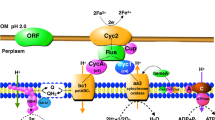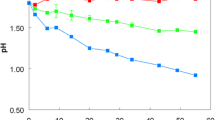Abstract
Growth physiology of the iron-reducing bacteria Thermoterrabacterium ferrireducens and Thermoanaerobacter siderophilus was investigated. The stimulation of the organotrophic growth of T. ferrireducens and T. siderophilusin the presence of Fe(III) was shown to be due to the utilization of ferric iron as an electron acceptor in catabolic processes and not to the effect exerted on the metabolism by Fe(II) or by changes in the redox potential. It was established that Fe(III) reduction in T. ferrireducens is not a detoxication strategy. In T. siderophilus, this process is carried out to alleviate the inhibitory effect of hydrogen. T. ferrireducens was shown to be capable of lithoautotrophic growth with molecular hydrogen as an electron donor and amorphous ferric oxide as an electron acceptor, in the absence of any organic substances. The minimum threshold of H2 consumption was 3 × 10–5 vol % of H2. The presence of CO dehydrogenase activity in T. ferrireducens suggests that CO2 fixation in this organism involves the anaerobic acetyl-CoA pathway. T. siderophilus failed to grow under lithoautotrophic conditions. The fact that T. ferrireducens contains c-type cytochromes and T. siderophilus lacks them confirms the operation of different mechanisms of ferric iron reduction in these species.
Similar content being viewed by others
REFERENCES
Slobodkin, A.I., Zavarzina, D.G., Sokolova, T.G., and Bonch-Osmolovskaya, E.A., Dissimilatory Reduction of Inorganic Electron Acceptors by Thermophilic Anaerobic Prokaryotes, Mikrobiologiya, 1999, vol. 68,no. 5, pp. 600-622.
Slobodkin, A.I., Eroshchev-Shak, V.A., Kostrikina, N.A., Lavrushin, V.Yu., Dainyak, L.G., and Zavarzin, G.A., Formation of Magnetite by Thermophilic Anaerobic Microorganisms, Dokl. Akad. Nauk, 1995, vol. 345,no. 5, pp. 694-697.
Slobodkin, A.I. and Wiegel, J., Fe(III) as an Electron Acceptor for H2 Oxidation in Thermophilic Anaerobic Enrichment Cultures from Geothermal Areas, Extremophiles, 1997, vol. 1, pp. 106-109.
Slobodkin, A., Campbell, B., Cary, S.C., Bonch-Osmolovskaya, E., and Jeanthon, C., Evidence for the Presence of Thermophilic Fe(III)-Reducing Microorganisms in Deep-Sea Hydrothermal Vents at 13° N (East Pacific Rise), FEMS Microbiol. Ecol., 2001, vol. 36, pp. 235-243.
Liu, S.V., Zhou, J., Zhang, C., Cole, D.R., Gajdarziska-Josifovska, M., and Phelps, T.J., Thermophilic Fe(III)-Reducing Bacteria from the Deep Subsurface: The Evolutionary Implications, Science, 1997, vol. 277, pp. 1106-1109.
Slobodkin, A., Jeanthon, C., L'Haridon, S., Nazina, T., Miroshnichenko, M., and Bonch-Osmolovskaya, E., Dissimilatory Reduction of Fe(III) by Thermophilic Bacteria and Archaea in Deep Subsurface Petroleum Reservoirs of Western Siberia, Curr. Microbiol., 1999, vol. 39, pp. 99-102.
Boone, D.R., Liu, Y., Zhao, Z.-J., Balkwill, D.L., Drake, G.R., Stevens, T.O., and Aldrich, H.C., Bacillus infernus sp. nov., an Fe(III)-and Mn(IV)-Reducing Anaerobe from the Deep Terrestrial Subsurface, Int. J. Syst. Bacteriol., 1995, vol. 45, pp. 441-448.
Greene, A.C., Patel, B.K.C., and Sheehy, A.J., Deferribacter thermophilus gen. nov., sp. nov., a Novel Thermophilic Manganese-and Iron-Reducing Bacterium Isolated from a Petroleum Reservoir, Int. J. Syst. Bacteriol., 1986, vol. 47, pp. 505-509.
Slobodkin, A., Reysenbach, A.-L., Srutz, N., Dreier, M., and Wiegel, J., Thermoterrabacterium ferrireducens gen. nov., sp. nov., a Thermophilic Anaerobic Dissimilatory Fe(III)-Reducing Bacterium from a Continental Hot Spring, Int. J. Syst. Bacteriol., 1997, vol. 47, pp. 541-547.
Slobodkin, A.I., Tourova, T.P., Kuznetsov, B.B., Kostrikina, N.A., Chernyh, N.A., and Bonch-Osmolovskaya, E.A., Thermoanaerobacter siderophilus sp. nov., a Novel Dissimilatory Fe(III)-Reducing, Anaerobic, Thermophilic Bacterium, Int. J. Syst. Bacteriol., 1999, vol. 49, p. 1471-1478.
Takai, K., Sugai, A., Itoh, T., and Horikoshi, K., Paleococcus ferrophilus gen. nov., sp. nov., a Barophilic, Hyperthermophilic Archaeon from a Deep-Sea Hydrothermal Vent Chimney, Int. J. Syst. Evol. Microbiol., 2000, vol. 50, pp. 489-500.
Wiegel, J., Thermophilic Iron(III)-Reducing Bacteria, Abs. Third Int. Congress on Extremophiles, Hamburg, Germany, Sept. 3-7, 2000, p. 59.
Zavarzina, D.G., Biogeochemical Factors of the Transformation of Iron Compounds In a Reducing Environment, Cand. Sci. (Biol.) Dissertation, Geological Faculty, Moscow State Univ., Moscow, 2001.
Lovley, D.R., Dissimilatory Fe(III) and Mn(IV) Reduction, Microbiol. Rev., 1991, vol. 55, pp. 259-287.
Adams, M.W.W., The Metabolism of Hydrogen by Extremely Thermophilic, Sulfur-Dependent Bacteria, FEMS Microbiol. Rev., 1990, vol. 75, pp. 219-238.
Fardeau, M.-L., Cayol, J.-L., Magot, M., and Ollivier, B., Hydrogen Oxidation Abilities in the Presence of Thiosulfate as Electron Acceptor within the Genus Thermoanaerobacter, Curr. Microbiol., 1994, vol. 29, pp. 269-272.
Faudon, C., Fardeau, M.-L., Heim, J., Patel, B., Magot, M., and Ollivier, B., Peptide and Amino Acid Oxidation in the Presence of Thiosulfate by Members of the Genus Thermoanaerobacter, Curr. Microbiol., 1995, vol. 31, pp. 152-157.
Bonch-Osmolovskaya, E.A., Miroshnichenko, M.L., Chernykh, N.A., Kostrikina, N.A., Pikuta, E.V., and Rainey, F.A., Reduction of Elemental Sulfur by Moderately Thermophilic Organotrophic Bacteria and the Description of Thermoanaerobacter sulfurophilus sp. nov., Mikrobiologiya 1997, vol. 66,no. 5, pp. 581-587.
Kashefi, K., Tor, J.M., Holmes, D.E., Gaw Van Praagh, C.V., Reysenbach, A.L., and Lovley, D.R., Geoglobus ahangari gen. nov., sp. nov., a Novel Hyperthermophilic Archaeon Capable of Oxidizing Organic Acids and Growing Autotrophically on Hydrogen with Fe(III) Serving as the Sole Electron Acceptor, Int. J. Syst. Evol. Microbiol., 2002, vol. 52, pp. 719-728.
Lovley, D.R. and Phillips, E.J.P., Competitive Mechanisms for Inhibition of Sulfate Reduction and Methane Production in the Zone of Ferric Iron Reduction in Sediments, Appl. Environ. Microbiol., 1987, vol. 53, pp. 2636-2641.
Drake, H.L., Acetogenesis, Acetogenic Bacteria, and the Acetyl-CoA “Wood/Ljugdahl” Pathway: Past and Current Perspectives, Acetogenesis Drake, H.L., Ed., New York: Chapman and Hall, 1994.
Richardson, D.J., Bacterial Respiration: A Flexible Process for a Changing Environment, Microbiology (UK), 2000, vol. 146, pp. 551-571.
Author information
Authors and Affiliations
Rights and permissions
About this article
Cite this article
Gavrilov, S.N., Bonch-Osmolovskaya, E.A. & Slobodkin, A.I. Physiology of Organotrophic and Lithotrophic Growth of the Thermophilic Iron-Reducing Bacteria Thermoterrabacterium ferrireducens and Thermoanaerobacter siderophilus. Microbiology 72, 132–137 (2003). https://doi.org/10.1023/A:1023299410478
Issue Date:
DOI: https://doi.org/10.1023/A:1023299410478




